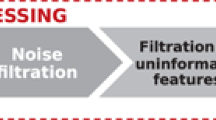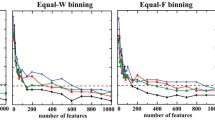Abstract
Molecular stratification of cancer patients is driving the development of precision medicine-targeted therapies. Clustering of tumor samples based on gene expression profiles from high-throughput platforms, such as microarrays or NextGen sequencing, has resulted in distinct tumor subtypes for numerous cancers. However, the majority of the derived classifiers or gene signatures have not reached clinical utility. Therefore, informatics methods to accurately translate the derived gene-signature from the high-throughput platform to a clinically adaptable low-dimensional platform are critical. In this chapter, we discuss a workflow to derive and then transfer gene signatures from one analytical platform to another for cancer patient stratification. We summarize the results of the workflow on two different cancers. Finally we discuss the importance of data-discretization in dealing with the cross-platform data and incorporating the splice-variant or isoform-level gene expression profiles in the statistical analyses.
Access this chapter
Tax calculation will be finalised at checkout
Purchases are for personal use only
Similar content being viewed by others
References
Steinberg M. Dasatinib: a tyrosine kinase inhibitor for the treatment of chronic myelogenous leukemia and philadelphia chromosome-positive acute lymphoblastic leukemia. Clin Ther. 2007;29:2289–308. http://www.ncbi.nlm.nih.gov/entrez/query.fcgi?cmd=Retrieve&db=PubMed&dopt=Citation&list_uids=18158072.
Deremer DL, Ustun C, Natarajan K. Nilotinib: a second-generation tyrosine kinase inhibitor for the treatment of chronic myelogenous leukemia. Clin Ther. 2008;30:1956–75. http://www.ncbi.nlm.nih.gov/entrez/query.fcgi?cmd=Retrieve&db=PubMed&dopt=Citation&list_uids=19108785.
Saglio G, Baccarani M. First-line therapy for chronic myeloid leukemia: new horizons and an update. Clin Lymphoma Myeloma Leuk. 2010;10:169–76. http://www.ncbi.nlm.nih.gov/entrez/query.fcgi?cmd=Retrieve&db=PubMed&dopt=Citation&list_uids=20511160.
Qin H, Chan MW, Liyanarachchi S, Balch C, Potter D, Souriraj IJ, et al. An integrative ChIP-chip and gene expression profiling to model SMAD regulatory modules. BMC Syst Biol. 2009;3:73. http://www.ncbi.nlm.nih.gov/pubmed/19615063.
Vitucci M, Hayes DN, Miller CR. Gene expression profiling of gliomas: merging genomic and histopathological classification for personalised therapy. Br J Cancer. 2010;104:545–53. http://www.ncbi.nlm.nih.gov/entrez/query.fcgi?cmd=Retrieve&db=PubMed&dopt=Citation&list_uids=21119666.
Yeghiazaryan K, Peeva V, Shenoy A, Schild HH, Golubnitschaja O. Chromium-picolinate therapy in diabetes care: molecular and subcellular profiling revealed a necessity for individual outcome prediction, personalised treatment algorithms and new guidelines. Infect Disord Drug Targets. 2011;11:188–95. http://www.ncbi.nlm.nih.gov/entrez/query.fcgi?cmd=Retrieve&db=PubMed&dopt=Citation&list_uids=21470100.
Gerstein MB, Bruce C, Rozowsky JS, Zheng D, Du J, Korbel JO, et al. What is a gene, post-ENCODE? History and updated definition. Genome Res. 2007;17:669–81. http://www.ncbi.nlm.nih.gov/pubmed/17567988.
Pal S, Gupta R, Kim H, Wickramasinghe P, Baubet V, Showe LC, et al. Alternative transcription exceeds alternative splicing in generating the transcriptome diversity of cerebellar development. Genome Res. 2011;21:1260–72. http://www.ncbi.nlm.nih.gov/pubmed/21712398.
Pan Q, Shai O, Lee LJ, Frey BJ, Blencowe BJ. Deep surveying of alternative splicing complexity in the human transcriptome by high-throughput sequencing. Nat Genet. 2008;40:1413–5. http://www.ncbi.nlm.nih.gov/pubmed/18978789.
Wang ET, Sandberg R, Luo S, Khrebtukova I, Zhang L, Mayr C, et al. Alternative isoform regulation in human tissue transcriptomes. Nature. 2008;456:470–6. http://www.ncbi.nlm.nih.gov/entrez/query.fcgi?cmd=Retrieve&db=PubMed&dopt=Citation&list_uids=18978772.
Khoury MP, Bourdon JC. p53 isoforms: an intracellular microprocessor? Genes Cancer. 2011;2:453–65. http://www.ncbi.nlm.nih.gov/pubmed/21779513.
Grabowski P. Alternative splicing takes shape during neuronal development. Curr Opin Genet Dev. 2011;21:388–94. http://www.ncbi.nlm.nih.gov/pubmed/21511457.
Tazi J, Bakkour N, Stamm S. Alternative splicing and disease. Biochim Biophys Acta. 2009;1792:14–26. http://www.ncbi.nlm.nih.gov/pubmed/18992329.
Botta A, Malena A, Tibaldi E, Rocchi L, Loro E, Pena E, et al. MBNL142 and MBNL143 gene isoforms, overexpressed in DM1-patient muscle, encode for nuclear proteins interacting with Src family kinases. Cell Death Dis. 2013;4:e770. http://www.ncbi.nlm.nih.gov/pubmed/23949219.
Twine NA, Janitz K, Wilkins MR, Janitz M. Whole transcriptome sequencing reveals gene expression and splicing differences in brain regions affected by Alzheimer’s disease. PLoS One. 2011;6:e16266. http://www.ncbi.nlm.nih.gov/pubmed/21283692.
Birzele F, Voss E, Nopora A, Honold K, Heil F, Lohmann S, et al. CD44 isoform status predicts response to treatment with anti-CD44 antibody in Cancer patients. Clin Cancer Res. 2015;21:2753–62. http://www.ncbi.nlm.nih.gov/pubmed/25762343.
Zhang Y, Chen K, Sloan SA, Bennett ML, Scholze AR, O’Keeffe S, et al. An RNA-sequencing transcriptome and splicing database of glia, neurons, and vascular cells of the cerebral cortex. J Neurosci. 2014;34:11929–47. http://www.ncbi.nlm.nih.gov/pubmed/25186741.
Pal S, Gupta R, Davuluri RV. Alternative transcription and alternative splicing in cancer. Pharmacol Ther. 2012;136:283–94. http://www.ncbi.nlm.nih.gov/pubmed/22909788.
Lapuk A, Marr H, Jakkula L, Pedro H, Bhattacharya S, Purdom E, et al. Exon-level microarray analyses identify alternative splicing programs in breast cancer. Mol Cancer Res. 2010;8:961–74. http://www.ncbi.nlm.nih.gov/entrez/query.fcgi?cmd=Retrieve&db=PubMed&dopt=Citation&list_uids=20605923.
Misquitta-Ali CM, Cheng E, O’Hanlon D, Liu N, McGlade CJ, Tsao MS, et al. Global profiling and molecular characterization of alternative splicing events misregulated in lung cancer. Mol Cell Biol. 2010;31:138–50. http://www.ncbi.nlm.nih.gov/entrez/query.fcgi?cmd=Retrieve&db=PubMed&dopt=Citation&list_uids=21041478.
Ebert B, Bernard OA. Mutations in RNA splicing machinery in human cancers. N Engl J Med. 2011;365:2534–5. http://www.ncbi.nlm.nih.gov/pubmed/22150007.
Venables JP, Klinck R, Koh C, Gervais-Bird J, Bramard A, Inkel L, et al. Cancer-associated regulation of alternative splicing. Nat Struct Mol Biol. 2009;16:670–6. http://www.ncbi.nlm.nih.gov/pubmed/19448617.
Omenn GS, Yocum AK, Menon R. Alternative splice variants, a new class of protein cancer biomarker candidates: findings in pancreatic cancer and breast cancer with systems biology implications. Dis Markers. 2010;28:241–51. http://www.ncbi.nlm.nih.gov/pubmed/20534909.
Skotheim RI, Nees M. Alternative splicing in cancer: noise, functional, or systematic? Int J Biochem Cell Biol. 2007;39:1432–49. http://www.ncbi.nlm.nih.gov/pubmed/17416541.
Venables JP. Unbalanced alternative splicing and its significance in cancer. BioEssays. 2006;28:378–86. http://www.ncbi.nlm.nih.gov/pubmed/16547952.
Zhang Z, Pal S, Bi Y, Tchou J, Davuluri R. Isoform-level expression profiles provide better cancer signatures than gene-level expression profiles. Genome Med. 2013;5:33. http://www.ncbi.nlm.nih.gov/pubmed/23594586.
Pal S, Bi Y, Macyszyn L, Showe LC, O’Rourke DM, Davuluri RV. Isoform-level gene signature improves prognostic stratification and accurately classifies glioblastoma subtypes. Nucleic Acids Res. 2014;42:e64. http://www.ncbi.nlm.nih.gov/pubmed/24503249.
Liu H, Hussain F, Tan CL, Dash M. Discretization: an enabling technique. Data Min Knowl Disc. 2002;6:393–423.
Diaz-Uriarte R, Alvarez de Andres S. Gene selection and classification of microarray data using random forest. BMC Bioinformatics. 2006;7:3. http://www.ncbi.nlm.nih.gov/pubmed/16398926.
Shilpi A, Kandpal M, Ji Y, Seagle BL, Shahabi S, Davuluri RV. Platform-independent classification system for predicting high-grade serous ovarian carcinoma molecular subtypes. JCO Clin Cancer Inform. 2019;3:1–9.
Turro E, Lewin A, Rose A, Dallman MJ, Richardson S. MMBGX: a method for estimating expression at the isoform level and detecting differential splicing using whole-transcript Affymetrix arrays. Nucleic Acids Res. 2010;38:e4. https://www.ncbi.nlm.nih.gov/pubmed/19854940.
Workman C, Jensen LJ, Jarmer H, Berka R, Gautier L, Nielser HB, et al. A new non-linear normalization method for reducing variability in DNA microarray experiments. Genome Biol. 2002;3:research0048. http://www.ncbi.nlm.nih.gov/pubmed/12225587.
Li B, Dewey CN. RSEM: accurate transcript quantification from RNA-Seq data with or without a reference genome. BMC Bioinformatics. 2011;12:323. http://www.ncbi.nlm.nih.gov/pubmed/21816040.
Kim H, Bi Y, Davuluri RV. Estimating the expression of transcript isoforms from mRNA-Seq via nonnegative least squares. In: Proceedings of the 10th IEEE International Conference Bioinformatics and Bioengineering, Philadelphia, PA, USA; 2010. p. 296–7. http://ieeexplore.ieee.org/stamp/stamp.jsp?tp=&arnumber=5521668.
Bray NL, Pimentel H, Melsted P, Pachter L. Near-optimal probabilistic RNA-seq quantification. Nat Biotechnol. 2016;34:525–7. https://www.ncbi.nlm.nih.gov/pubmed/27043002.
Dapas M, Kandpal M, Bi Y, Davuluri RV. Comparative evaluation of isoform-level gene expression estimation algorithms for RNA-seq and exon-array platforms. Br Bioinform. 2016;18:260–9. https://www.ncbi.nlm.nih.gov/pubmed/26944083.
Law CW, Chen Y, Shi W, Smyth GK. Voom: precision weights unlock linear model analysis tools for RNA-seq read counts. Genome Biol. 2014;15:R29. http://www.ncbi.nlm.nih.gov/pubmed/24485249.
Wilkerson MD, Hayes DN. ConsensusClusterPlus: a class discovery tool with confidence assessments and item tracking. Bioinformatics. 2010;26:1572–3. http://www.ncbi.nlm.nih.gov/pubmed/20427518.
Rousseeuw PJ. Silhouettes: a graphical aid to the interpretation and validation of cluster analysis. Comput Appl Math. 1987;20:53–65.
Jung S, Bi Y, Davuluri RV. Evaluation of data discretization methods to derive platform independent gene expression signatures for multi-class tumor subtyping. BMC Genomics. 2015;11(16 Suppl):S3.
Diaz-Uriarte R. GeneSrF and varSelRF: a web-based tool and R package for gene selection and classification using random forest. BMC Bioinformatics. 2007;8:328. http://www.ncbi.nlm.nih.gov/pubmed/17767709.
Breiman L. Random forests. Mach Learn. 2001;45:5–32.
Jung S, Bi Y, Davuluri RV. Evaluation of data discretization methods to derive platform independent isoform expression signatures for multi-class tumor subtyping. BMC Genomics. 2015;16(Suppl 1):S3. http://www.ncbi.nlm.nih.gov/pubmed/26576613.
Liu Q, Sung AH, Chen Z, Liu J, Chen L, Qiao M, et al. Gene selection and classification for cancer microarray data based on machine learning and similarity measures. BMC Genomics. 2011;12(Suppl 5):S1. http://www.ncbi.nlm.nih.gov/pubmed/22369383.
Gupta R, Wikramasinghe P, Bhattacharyya A, Perez FA, Pal S, Davuluri RV. Annotation of gene promoters by integrative data-mining of ChIP-seq pol-II enrichment data. BMC Bioinformatics. 2010;11(Suppl 1):S65. http://www.ncbi.nlm.nih.gov/pubmed/20122241.
Therneau TM, Grambsch PM. Modeling survival data: extending the cox model. New York, NY: Springer; 2000.
Dunn GP, Rinne ML, Wykosky J, Genovese G, Quayle SN, Dunn IF, et al. Emerging insights into the molecular and cellular basis of glioblastoma. Genes Dev. 2012;26:756–84. http://www.ncbi.nlm.nih.gov/pubmed/22508724.
Verhaak RG, Hoadley KA, Purdom E, Wang V, Qi Y, Wilkerson MD, et al. Integrated genomic analysis identifies clinically relevant subtypes of glioblastoma characterized by abnormalities in PDGFRA, IDH1, EGFR, and NF1. Cancer Cell. 2010;17:98–110. http://www.ncbi.nlm.nih.gov/pubmed/20129251.
Siegel RL, Miller KD, Jemal A. Cancer statistics, 2016. CA Cancer J Clin. 2016;66:7–30. https://www.ncbi.nlm.nih.gov/pubmed/26742998.
Reid BM, Permuth JB, Sellers TA. Epidemiology of ovarian cancer: a review. Cancer Biol Med. 2017;14:9–32. https://www.ncbi.nlm.nih.gov/pubmed/28443200.
Tothill RW, Tinker AV, George J, Brown R, Fox SB, Lade S, et al. Novel molecular subtypes of serous and endometrioid ovarian cancer linked to clinical outcome. Clin Cancer Res. 2008;14:5198–208. https://www.ncbi.nlm.nih.gov/pubmed/18698038.
Cancer Genome Atlas Research N. Integrated genomic analyses of ovarian carcinoma. Nature. 2011;474:609–15. https://www.ncbi.nlm.nih.gov/pubmed/21720365.
Tanaka S, Louis DN, Curry WT, Batchelor TT, Dietrich J. Diagnostic and therapeutic avenues for glioblastoma: no longer a dead end? Nat Rev Clin Oncol. 2013;10:14–26. http://www.ncbi.nlm.nih.gov/pubmed/23183634.
Huse JT, Holland E, DeAngelis LM. Glioblastoma: molecular analysis and clinical implications. Annu Rev Med. 2013;64:59–70. http://www.ncbi.nlm.nih.gov/pubmed/23043492.
Acknowledgments
This work was supported by the National Library of Medicine of the National Institutes of Health [Award Number R01LM011297 to RD]. The content is solely the responsibility of the authors and does not necessarily represent the official views of the National Institutes of Health.
Author information
Authors and Affiliations
Corresponding author
Editor information
Editors and Affiliations
Rights and permissions
Copyright information
© 2020 Springer Nature Switzerland AG
About this chapter
Cite this chapter
Bi, Y., Davuluri, R.V. (2020). Platform-Independent Gene-Expression Based Classification-System for Molecular Sub-typing of Cancer. In: Adam, T., Aliferis, C. (eds) Personalized and Precision Medicine Informatics. Health Informatics. Springer, Cham. https://doi.org/10.1007/978-3-030-18626-5_10
Download citation
DOI: https://doi.org/10.1007/978-3-030-18626-5_10
Published:
Publisher Name: Springer, Cham
Print ISBN: 978-3-030-18625-8
Online ISBN: 978-3-030-18626-5
eBook Packages: MedicineMedicine (R0)




